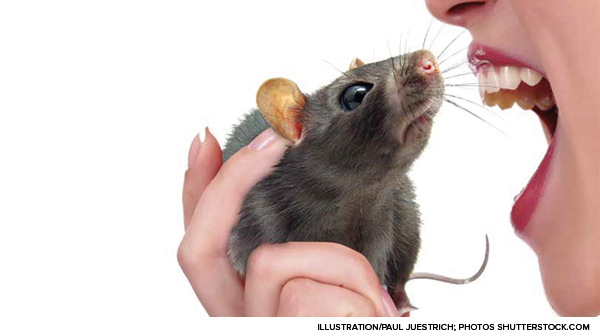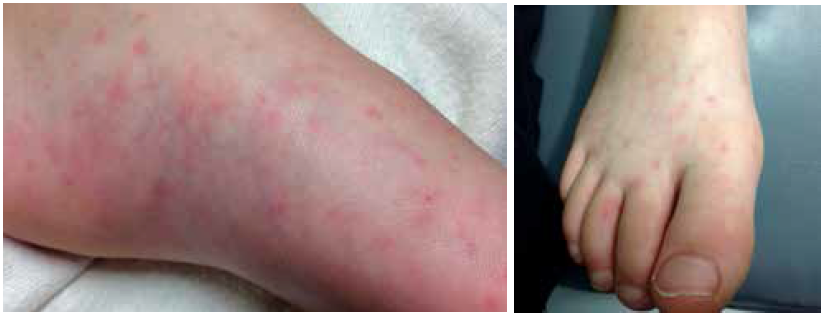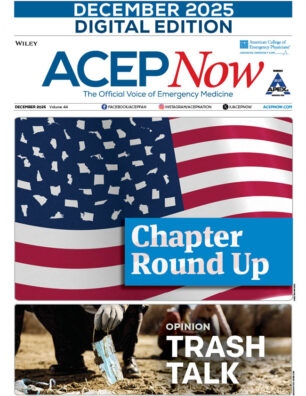
The Case
Chief complaint: fever and rash. I stare at the triage notes of the eight-year-old female I had just picked up. Overwhelmed by the vast differential that comes to mind, I decide to approach the case by first ruling out the most life-threatening diagnoses, such as meningococcemia and Stevens-Johnson syndrome, even though they are highly unlikely in my patient.
As an EM intern, I’m still developing a sense for distinguishing “sick” versus “not sick,” but upon entering my patient’s room, I know immediately this girl is “sick.” A thin, pale child lies before me, splayed out on the stretcher and holding her right arm across her chest. She doesn’t even look up when I introduce myself. A morbilliform rash peeks through her gown, and I notice the rash on her face, extremities, palms, and soles (see Figure 1). “Palms and soles…” I recall the more-focused differential for a palms/soles rash: meningococcemia; Rocky Mountain spotted fever; hand, foot, and mouth disease; secondary syphilis…
The parents describe their child as becoming progressively more “lethargic” and febrile over the past week (Tmax 104°F). They had already visited the pediatrician three times but decided it was time to come to the ED when the patient woke up refusing to walk due to pain in her knees and ankles. Delving into my bank of fever questions, I ask about headache, neck stiffness, skipped vaccinations, sick contacts, recent travel, or any new medications. However, all of these questions return negative. Fever, rash, joint pain—what else could I ask? At a loss, I decide to ask about any known tick bites, though this is unlikely because we are at the peak of winter in New England. Still negative. Any new pets? Well, now that I mention it, they admit to buying a new pet rat a few weeks ago.
On exam, the patient appears very fatigued. Her vital signs are significant for a fever of 38°C and heart rate of 126 bpm. Her respiratory rate, blood pressure, and SpO2 are within normal limits. The most striking exam findings are the patient’s pallor contrasted against a blanching morbilliform rash over her face, extremities, palms, and soles but sparing her torso. I also notice a petechial rash developing on the patient’s legs that I hadn’t seen previously. Despite mild postauricular lymphadenopathy, the rest of her head, eyes, ears, nose, and throat exam is normal. Her heart, lung, and abdomen exams are also normal. However, when I attempt to move the patient’s right shoulder and ankles, she moans in pain.
Rat-Bite Fever
As I return to my desk, the history of a new pet rat continues to resonate in my mind. I search the Internet for rat-borne diseases, and a recent news article appears as one of the top search results.1 The article describes the case of a young boy misdiagnosed with a viral illness, but worsening of his symptoms resulted in his death a few days later. On autopsy, the boy was found to be infected with the bacterium causing rat-bite fever (RBF), Streptobacillus moniliformis.
The article further discusses the symptoms of RBF, which include fever (check), rash (check), and arthralgias (check) in a patient with exposure to rats (check). My attending and I are amazed how closely this diagnosis fits our patient. Upon further questioning, the patient denies any rat bites. However, she does admit to allowing the rat to lick her mouth and lips, much to my dismay. With guidance from a pediatric infectious disease specialist, we draw blood cultures and start empiric antibiotic therapy for RBF. The patient’s basic lab work returns at this point and is remarkable for a platelet count of 178K and C-reactive protein of 4.9 mg/L. The rest of her complete blood count, basic metabolic panel, liver function test, and erythrocyte sedimentation rate are within normal limits.
The patient is admitted to the hospital on IV doxycycline (2 mg/kg BID), and her symptoms begin to improve the following day. She is discharged within 48 hours, with increased energy, a fading rash, and no joint pain. She is instructed to continue PO doxycycline for two weeks. At follow-up one month later, the parents state their daughter is “perfect” and back to her normal self.
RBF is a rare but fatal bacterial illness in the United States caused predominantly by S. moniliformis, a gram-negative rod that is part of the normal respiratory flora of rodents.2 It is spread to humans via a rat bite, scratch, or, in my patient’s case, a “kiss,” but it is susceptible to antibiotics such as penicillin or doxycycline (see sidebar for dosing). If misdiagnosed or left untreated, however, the disease carries a 13 percent mortality rate.3 Symptoms present anywhere from three to 21 days after rat exposure and include nonspecific symptoms such as fever, fatigue, headache, pharyngitis, and vomiting. These initial symptoms are followed by a rash, which is usually maculopapular, though it can be petechial or purpuric, and is most prominent on the extremities, palms, and soles. Polyarticular and asymmetric arthralgias develop in up to 50 percent of patients. When RBF is suspected, blood cultures should be drawn with specific instructions (see sidebar), as S. monilifomis is a fastidious organism.
Although RBF is a rare diagnosis, this case highlights the importance of taking a thorough history. Having a standard list of questions at your disposal to help sort out nonspecific symptoms, such as fever and rash, is crucial to avoid missing a fatal illness. Although it is unlikely I will encounter another case of RBF, this case serves as a reminder to maintain an open differential and to be less inclined to diagnose a viral illness without first considering other life-threatening diagnoses.
Dr. Vetter is a resident in emergency medicine at the University of Connecticut in Hartford.
References
- Adam JK, Varan AK, Pong AL, et al. Notes from the field: fatal rat-bite fever in a child—San Diego County, California, 2013. Morb Mortal Wkly Rep. 2014;63:1210-1211.
- Pickering LK, Baker CJ, Kimberlin DW, et al. Red book: 2009 report of the Committee on Infectious Diseases. 28th ed. Elk Grove Village, Ill: American Academy of Pediatrics; 2009:299-300.
- US Department of Health and Human Services. Rat-bite fever (RBF). 2012. Available at: www.cdc.gov/rat-bite-fever/health-care-workers/index.html. Accessed Feb. 16, 2015.
- Elliott SP. Rat bite fever and Streptobacillus moniliformis. Clin Microbiol Rev 2007;20:13-22.
Pages: 1 2 3 | Multi-Page







2 Responses to “Rat-Bite Fever’s Non-Specific Symptoms Make Patient History Important for Diagnosis”
March 29, 2015
Stephen ColuccielloThe dose for IV PCN is WAY too low. “◾IV penicillin G: 200,000 units every 4 hours for 5–7 days (can be switched to PO once patient shows clinical improvement)”
This should be 2,000,000 (two million NOT two hundred thousand) q 4 h.
Off by a factor of 10!
March 29, 2015
Randall dloanNever heard of this .